Using Google Trends for Business and Content Ideas: Practical Examples and Strategies for Marketers and Freelancers
Introduction
If you’re wondering how to use Google Trends to generate business ideas or content ideas, you’ve come to the right place. As someone who’s been in the marketing trenches for a while, I can tell you this free tool is an invaluable resource for marketers, bloggers, and anyone looking to stay ahead of the game. Google Trends can help you identify popular search terms, their seasonality, and geographical interest. This data is pure gold when it comes to generating ideas for content, new niches, and even products or businesses.
In this article, I’ll first share some practical tips and tricks for using Google Trends to take your content ideas and market research to the next level. At the end of the article, you’ll find practical examples of how to use trending topics in your content and as freelance side-hustles. You can also watch the video below to jump right into 3 marketing role-plays demonstrating creative ways to use Google Trends.
So, whether you’re a seasoned pro or just getting started, let’s dive in and explore the power of Google Trends!
Table of Contents
Understanding Google Trends
Google Trends is a free tool that provides valuable insights into what people are searching for on Google Search. Here’s what you need to know to understand and use this tool effectively:
What is Google Trends?
Google Trends is a tool that shows the popularity of search terms over time, including their seasonality and geographical interest. It allows users to explore the relative popularity of multiple search terms and identify trending topics.
Where is Google Trends?
Google Trends is a web-based tool that can be accessed through the Google Trends website. You’ll have the option to search for terms or browse current trending topics.
How much does Google Trends cost?
Google Trends is a completely free tool that anyone can use to gain insights into what people are searching for on Google.
What are trending Google searches?
Trending Google searches are search terms that have recently seen a significant surge in popularity on Google Search. It’s real-time data on what people are interested in and gives you a starting place for the who, what, when, how, and why. This information can be incredibly useful for businesses and content creators looking to stay on top of the latest trends and create relevant content that resonates with their audience. Using it will help you create content and marketing campaigns that are relevant sought-after.
How does Google Trends work?
So, let’s summarize how Google Trends works. This tool collects data from Google Search and presents it in different forms, such as search volume, related queries, and topic trends. Google Trends uses a mix of algorithms and data visualization to provide insights into how popular search terms are across different regions and over time. With Google Trends, you can compare multiple search terms, filter data by location and time, and even explore related queries and topics. This makes it easy to get a sense of what people are searching for and how trends change over time.
Key features of Google Trends
Some of the key features of Google Trends include the ability to compare multiple search terms, filter data by location and time, and explore related queries and topics. Users can also see which search terms are currently trending and view real-time data for the most popular search terms.
Benefits of using Google Trends
Google Trends can help businesses and content creators identify popular search terms and trending topics, explore seasonal trends and geographical interest, and generate fresh content ideas. Best of all, it’s a free tool that is accessible to businesses and content creators of all sizes.
In short, Google Trends is a free and powerful tool for anyone looking to stay on top of the latest trends and generate fresh content ideas. Let’s dive deeper into how Google Trends data works in the next section.
What does Google Trends Tell You?
Google Trends will tell you 3 things about search behavior: the relative popularity of search terms over time, differences in geographical interest, and related phrases that are trending. Here’s what each of these numbers mean:
Interest Over Time and Seasonality
One of the coolest things about Google Trends is that it allows you to look at interest over time. The data is presented in the form of a graph, with the y-axis representing the search interest and the x-axis representing the time frame. By analyzing the graph, you can easily identify the peak periods of search interest and understand how the popularity of search terms changes over time. Let’s look at the data for “Saint Patrick’s Day” as of March 13th, 2023 (4 days before Saint Patrick’s Day).
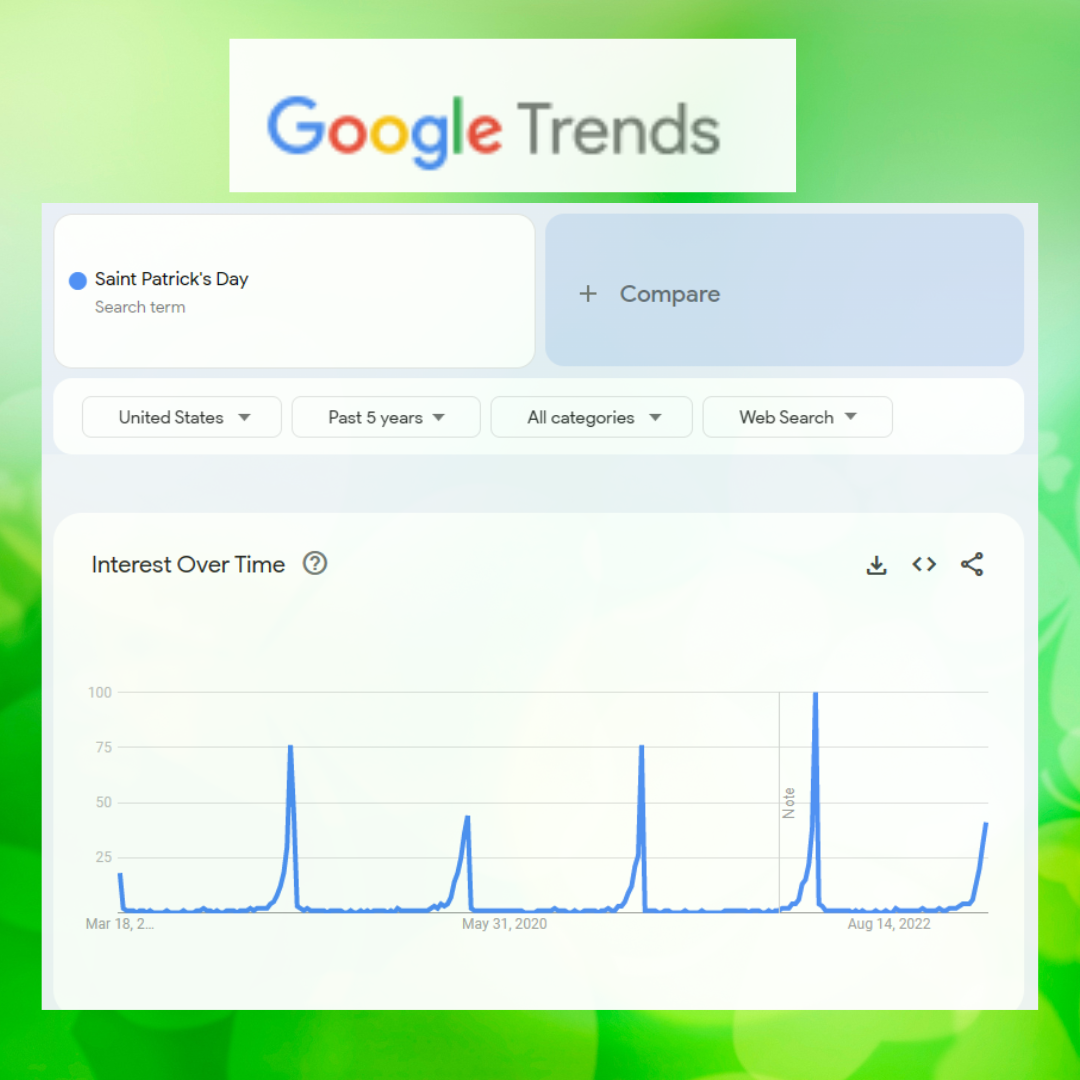
Differences in geographical interest
Google Trends also shows the differences in geographical interest for search terms. You can see which regions have the highest search interest for a particular term and compare it to other regions. You can do this within a country or across countries. This can help creators and business owners make decisions on ad targeting, logistics, translations, and more.
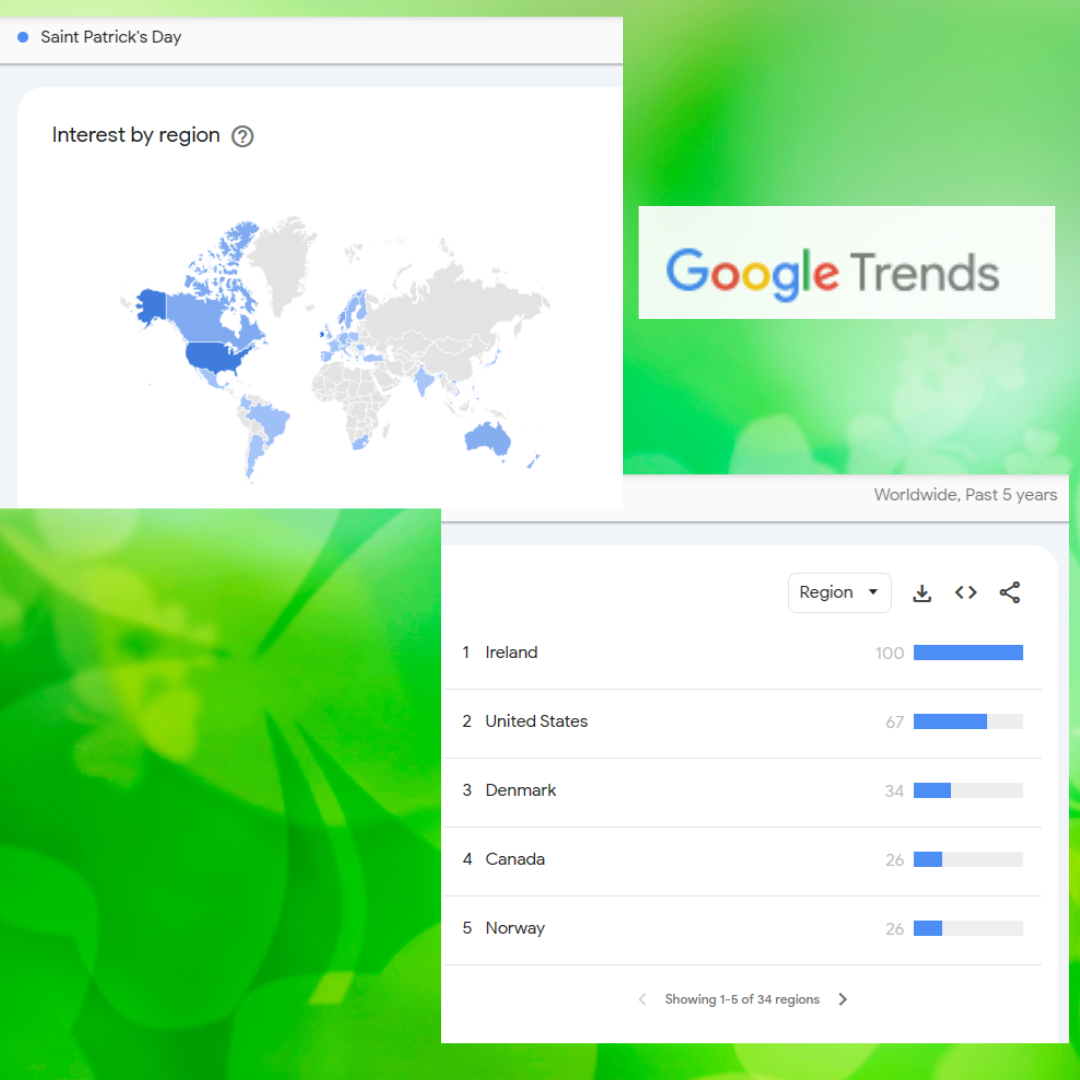
Related Topics and Related Queries that are trending
Google Trends provides data on related topics and queries that are currently trending. This can help businesses and content creators identify parallel emerging trends and explore other topics that might relevant to their audience. By analyzing related queries, you can also identify the intent behind the search and create content that meets the needs of your audience.
Google Trends breaks this section into Related Topics and Related Queries, which we will discuss in the next section.
How to read Google Trends
When exploring Google Trends, it’s important to understand how to read the data presented.
Google Trends Interest Over Time Explained
The numbers on the graph represent the search interest relative to the highest point on the graph, which is set to 100. This means that a value of 50 indicates that the search term is half as popular as it was at its peak.
It’s also important to understand how Google defines “rising” for trends. According to Google, rising refers to topics or queries with “the biggest increase in search frequency since the last time period.”
If a result is marked breakout, that means it “had a tremendous increase, probably because these queries are new and had few (if any) prior searches.”

Google Trends Related Topics vs. Related Queries
At first glance, related topics and related queries sound like the same thing. But, they’re very different and you’ll want to consider them as such as you try to deduce information about an audience based on a Google trend.
Related Topics: These are other searches made by users that also searched for term you are researching. You can view by the following metrics. Think of related topics as possible overlapping interests.
Related Queries: These are specific queries that people have searched for on Google that are related to the search term you entered into Google Trends. Think of related queries as possible related keywords.
Now that we have the basics of reading the data down, let’s move on to the step we’ve all been waiting for: Using Google Trends in our busines!
Using Google Trends for Business Ideas and Strategy Planning (Examples)
Now that we understand how to read and interpret data in Google Trends, let’s explore how we can use this information to inform our business and content strategy. In this section, we’ll cover topics like:
- How to best use Google Trends for keyword research and niche identification
- Using Google Trends for market research and competitive analysis
- Generating business ideas and content brainstorming with Google Trends
- How to incorporate Google Trends insights into your marketing strategies
Keyword research
While Google Trends shouldn’t be used as a replacement for a dedicated keyword research tool, it can provide valuable insights into the popularity of certain search terms over time. Use Google Trends to identify seasonal trends, regional differences in search behavior, and related queries and topics that can inform your keyword strategy.
Niche identification
Google Trends can help you identify emerging trends and new niches that are gaining popularity. By analyzing related topics and queries, you can identify areas where there is growing demand and create content or products that meet the needs of your target audience.
Market research
Use Google Trends to gain insights into the behavior of your target market, including what they are searching for, where they are located, and how their interests and preferences are changing over time. This information can help you create targeted marketing campaigns and optimize your content strategy.
Business ideas brainstorming
Google Trends can be a great tool for generating new business ideas. Use the tool to identify gaps in the market and emerging trends that you can capitalize on. You can also use Google Trends to identify areas where there is growing demand for certain products or services.
Marketing strategies
Incorporate Google Trends data into your marketing strategy to stay on top of the latest trends and reach your target audience with the right message at the right time. Use the data to inform your content strategy, social media marketing, and advertising campaigns.
By using Google Trends in these ways, you can gain a deeper understanding of your target audience and make data-driven decisions that lead to more effective marketing campaigns and a more successful business.
10 Ways to use Google Trends in your Marketing Research and Content Planning
Need new content ideas or ready to take your content planning to the next level? Here are 10 creative ways to use Google Trends to improve your content strategy:
- Identify popular topics: Use Google Trends to identify the most popular topics in your industry or niche. Create content around these topics to tap into the latest buzz and engage your audience.
- Identify parallel topics and keywords: Explore the related queries and topics that Google Trends provides to identify areas of interest that are related to your core topics. Use these as inspiration for new content ideas and new ways to word things you already talk about.
- Analyze seasonal trends: Use Google Trends to identify seasonal trends in search behavior. Create content that capitalizes on these trends and is relevant to your audience during specific times of the year. If the content can be reused in the same season next year, be sure to log it in your content planner for reposting!
- Find related queries and topics: Explore the related queries and topics that Google Trends provides to identify areas of interest that are related to your core topics. Use these as inspiration for new content ideas.
- Discover new niches: Use Google Trends to identify emerging trends and new niches that are gaining popularity. Be one of the first to create content in these areas and establish yourself as an authority in your field. For example, if a new sugar alternative is starting to gain traction professionals in multiple industries could have a new cluster of content to create around it.
- Optimize your headlines and captions: Use Google Trends to identify the most popular keywords and phrases related to your topic. Use these in your text copy to increase the chances of your content being discovered by search engines and noticed on social media.
- Plan your content calendar: Use Google Trends data to plan your content calendar and ensure that your content is timely, relevant, and meets the needs of your target audience. Search for holidays + your subregion + your category and start brainstorming.
- Analyze your competition: Use Google Trends to compare the search volume of your topics against your competitors. If you serve a local market, be sure to drill-down into subregion data.
- Stay on top of news and events: Use Google Trends to monitor search volume related to news and events in your industry or niche. Creating a quick social post with your thoughts on the story gives you the chance to include related keywords and hashtags – Take advantage of social platforms wanting to serve content people are talking about!
As an example, these are the top topics and queries relating to “Cocoa Beach” for the last 7 days. Creating content for social about these things would likely be highly viewed and shared.
- Target different regions: Use Google Trends to identify regional differences in search behavior. For example, a real estate agent in Florida might target winter weather regions for retirees who might want a nice summer home.
More Tips:
If the related terms are broad and far outside the scope of your industry, try using the category filter. Here is an example a real estate agent might use when looking for keyword and content ideas for social posts:
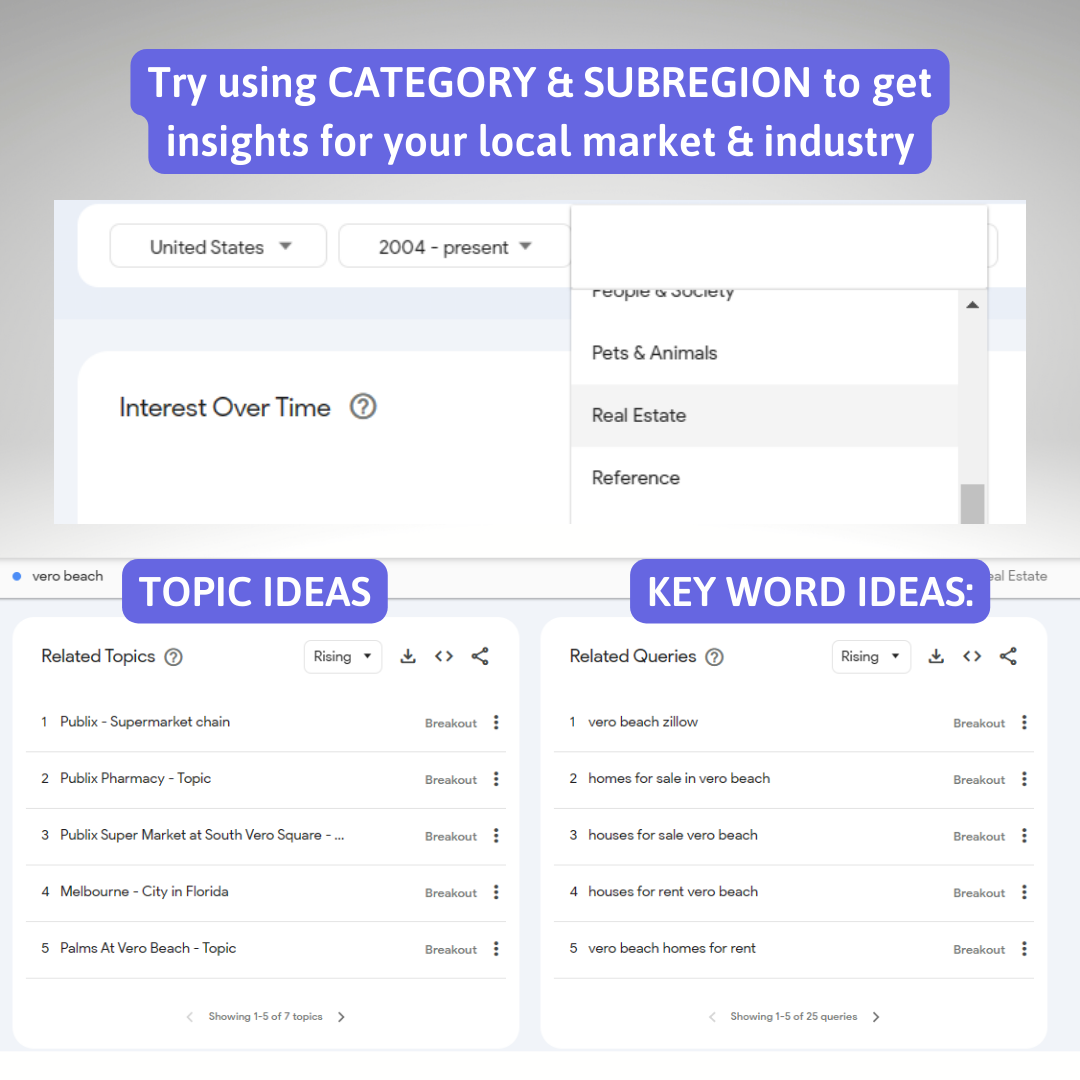
You can also check out How to show up in Google local search results: 6 easy tips for more on local marketing for small businesses.
HOW to use Google Trends in Your Content Strategy
Most business owners I talk to know trending topics are a great source of content ideas, but they don’t really understand how to talk about it from their brand or business page. They think, “Well, I sell bicycles: What do I care if Stevia is out and agave nectar is in?”
We make the mistake of thinking our brand and business have to have linear, monotonous content. But when have you ever had a conversation with another human where new ideas didn’t come in?
I wanted to demonstrate how different industries can use trending topics in their blogs, videos, and social posts, which are really just vehicles for one-to-many conversations.
Let’s say that a new sugar alternative is starting to gain traction. Professionals in multiple industries could have a new cluster of content to create around it, even if they aren’t sugar merchants. Here are some examples:
The obvious examples (and, where professionals usually say “I’m not one of these categories, so I can’t make content about this”):
- Healthcare: Create content about how the new sugar alternative can be used as a healthier alternative to traditional sugar in diabetic diets or for individuals with insulin resistance.
- Fitness: Create content about how the new sugar alternative can be used to fuel workouts or as a healthy alternative for athletes or active individuals.
- Foodie Influencer: Compare two recipes using the new sugar alternative vs. the old sugar.
The not-so-obvious examples:
- Local Business (e.g. Real Estate Agent, Chamber of Commerce Employee): Create content about local businesses that are using the new sugar alternative in their products or highlighting local suppliers who provide it.
- Retail: Create content about how the new sugar alternative is being used in food products or as a sweetener for health-conscious consumers, or highlight new products that incorporate it.
- Restaurant/Chef: Create content about how the new sugar alternative can be used in recipes or incorporated into menus to appeal to health-conscious diners.
- Insurance Professionals: Share content about the potential health benefits of the sugar alternative and how they can lead to healthier lifestyles and lower medical expenses
- Mobile Notary Services: Create content about how the new sugar alternative is being used in the food industry and how it can benefit local food truck vendors, restaurant owners, and other small business owners that the mobile notary service can help support.
- Photographer: Create a series of mouth-watering images featuring dishes that use the trending alternative sugar as the main ingredient, highlighting the visual appeal of the sugar and its versatility in different types of cuisine.
- Print Marketing Team: Create visually appealing infographics or pamphlets showcasing the benefits of the alternative sugar and how it can be used in food products or as a sweetener for health-conscious consumers. You’re subconsciously selling your marketing while educating!
- Landscaper: Create content about how the alternative sugar can be used to cultivate and maintain healthier gardens or how it can be used in natural weed control products to keep yards healthy and beautiful.
- Architect: Create content about how plant material used in the production of alternative sugar can be used in sustainable building materials or as an eco-friendly insulation product, highlighting benefits to the construction industry.
Stop being afraid that a trending topic isn’t an exact match to the product or service you sell. Instead, start viewing content creation as a way to start conversations.
If I want to engage an audience in Cocoa Beach, I could talk about the Red Tide, upcoming space launches, and Spring Break vacation ideas.
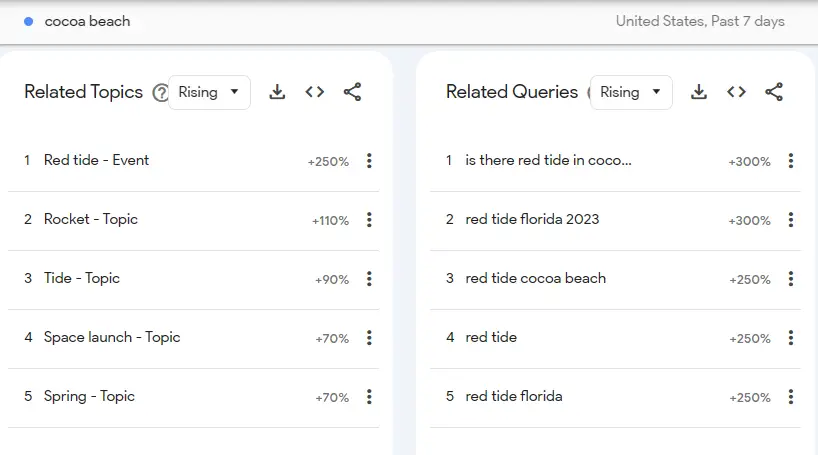
Try searching for trends in the last 7 days for your market or industry and use a popular topic to start a conversation (today!) on a social platform. Just do it.
How to use Google Trends to make money: 10 Freelance Ideas
There are many more ways to make money with Google Trends than I’ve covered in this article. To give you some inspiration and ideas for generating passive income or creating side-hustles, I’ve put together a list of digital products that you can create using Google Trends searches. Whether you’re a freelancer or a marketer manager, these ideas can serve as a starting point for monetizing your skills and expertise.
- E-books
- Infographics
- Online courses
- Social media graphics
- Webinars
- Podcasts
- Templates
- Research reports
- Data visualizations
- Stock photos
When you look at how something is trending, ask yourself if any of the 10 things above are lacking as available resources on the subject. If you create something to fill a gap, there will be customers looking for it.
Conclusion
To wrap things up, Google Trends is an absolutely free tool for anyone looking for new ideas in the world of marketing, content creation, and freelancing. Armed with the knowledge of how to read and interpret Google Trends data, you’re ready to make data-driven decisions about your business and content strategy, keeping you ahead of the curve and setting you up for success. Whether you’re a seasoned pro or just starting, Google Trends is something worth using every so often to jumpstart your research and refresh your keyword strategy. So, find some trends and put them to work!
The best free resource for more small business and SEO tips like this: Join the Brand Hacking Facebook Group


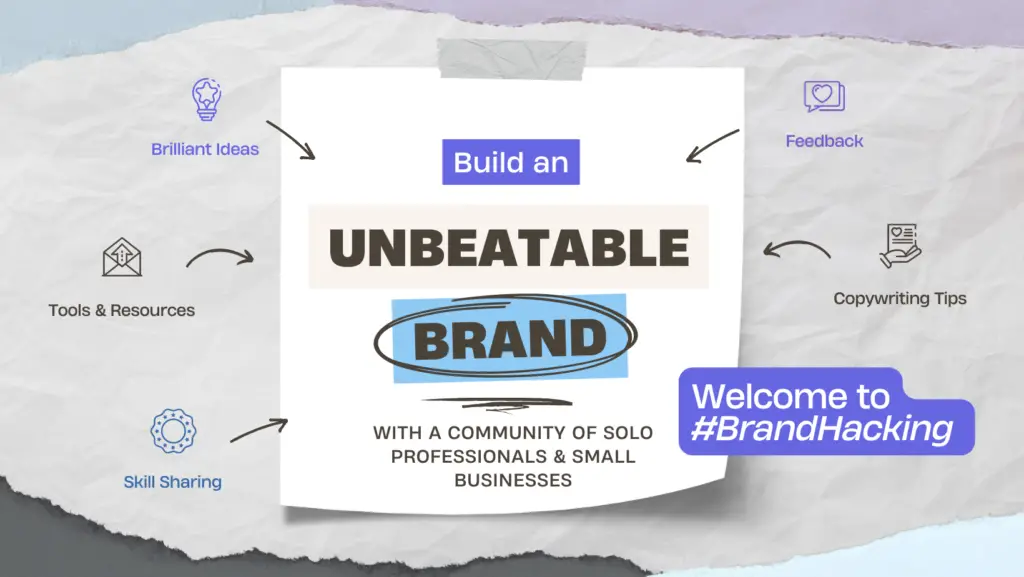
Excellent article. I’m dealing with some of these issues as well..
Amazing blog! Do you have any recommendations for aspiring writers?
I’m planning to start my own blog soon but I’m a
little lost on everything. Would you propose starting with a free platform like WordPress or go for a paid
option? There are so many choices out there that I’m totally overwhelmed ..
Any tips? Kudos!
Go with WordPress. There are so many resources online to help you learn to build and grow a blog through WordPress.
Most people get caught up with setting up their website for the first time. Those obstacles are really domain registration, setting up hosting and SSL certificates, and getting your website live.
I used to procrastinate because of this – but I learned how to go from domain name to live WordPress website in 20 minutes. I made a video about it here: https://kattwagner.com/easy-namecheap-cloudways-wordpress-website-setup/
Do not worry your site isn’t perfect or if you want to change how it looks in the future – Just get started. 🙂
I needed to thank you for this good read!! I absolutely
loved every little bit of it. I have you book-marked to check out new things you post…
Its like you read my mind! You seem to know so much about this,
like you wrote the book in it or something. I think that
you can do with a few pics to drive the message home a
bit, but instead of that, this is excellent blog. A fantastic read.
I will certainly be back.
Hello, i read your blog from time to time and i own a similar one and
i was just curious if you get a lot of spam feedback?
If so how do you protect against it, any plugin or anything you can recommend?
I get so much lately it’s driving me insane
so any assistance is very much appreciated.
I relish, lead to I discovered just what I was having a
look for. You have ended my four day long hunt! God Bless you man. Have a nice day.
Bye
Do you have a spam problem on this blog; I also am a blogger,
and I was wondering your situation; we have developed some nice methods and
we are looking to trade solutions with other folks, be sure to shoot me an e-mail if interested.
With havin so much content do you ever run into any
issues of plagorism or copyright infringement?
My blog has a lot of exclusive content I’ve either written myself or outsourced but it looks like a lot of it is popping it up all over the web without my authorization. Do you know any ways to help protect against content
from being ripped off? I’d certainly appreciate it.
Magnificent goods from you, man. I’ve understand your stuff previous to and you are just extremely great.
I actually like what you have received right here, certainly like what you are stating and
the way wherein you say it. You’re making it entertaining and you continue to care for to keep it smart.
I can’t wait to learn far more from you. This is actually a tremendous website.
Hey! Someone in my Myspace group shared this website with us so
I came to take a look. I’m definitely loving the information. I’m bookmarking and will be
tweeting this to my followers! Great blog and wonderful
design and style.
It’s very simple to find out any topic on web as compared to textbooks, as I found this piece of writing at this web site.
WOW just what I was looking for.
It’s amazing for me to have a website, which is valuable designed for my know-how.
thanks admin
Good blog you have here.. It’s difficult to find
good quality writing like yours these days.
I seriously appreciate individuals like you!
Take care!!
whoah this weblog is excellent i love studying your posts.
Keep up the good work! You realize, many persons are searching round for this information, you
can aid them greatly.
I am genuinely thankful to the holder of this web site who has shared this enormous post at here.
I’ve recently started a website, the info you offer on this website has helped me tremendously. Thank you for all of your time & work.